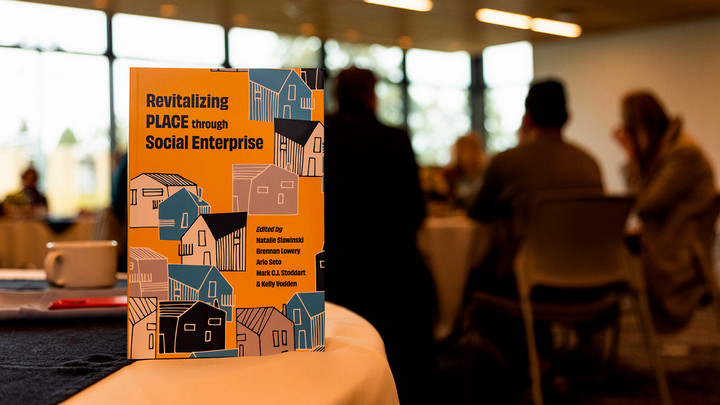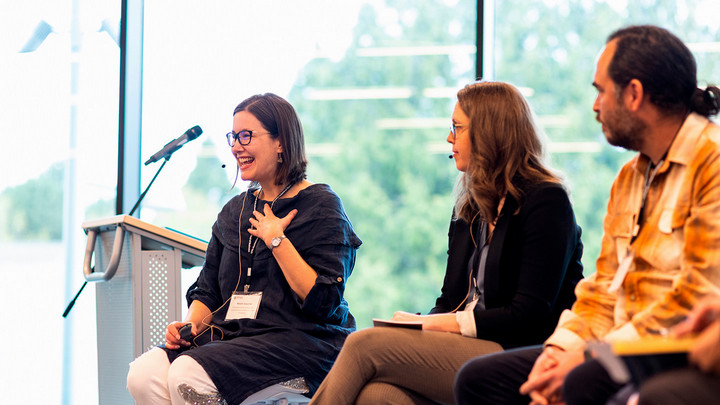Starting with place

New research explores how place-based social enterprises revitalize their communities despite socio-economic and environmental challenges—and how we can do the same.
Community leaders around the world are challenging traditional top-down hierarchical structures with bottom-up approaches that draw on and enhance their local places: from natural resources and geographic strengths to cultural history and the feeling we call ‘home’. Researchers present a new framework to examine the work of these leaders in the edited volume Revitalizing Place through Social Enterprise, published in December.
Lead editor and coauthor Natalie Slawinski hosted a book launch for the new volume yesterday, inviting community leaders from business, government and civil society to come together and share their experiences. Slawinski is professor of sustainability and strategy at Gustavson and director of the Centre for Social and Sustainable Innovation (now called the Centre of Regenerative Futures).
“As a newcomer to Victoria, it was heartwarming to be in a room full of community builders and to feel the energy and passion of these leaders who work so hard to make this place, and other places, stronger,” says Slawinski, “As a researcher, I was humbled by the deep expertise and lived experience of this group and the privilege to learn about their work.”

Collaboratively written by academics and practitioners, this new volume offers case studies of place-based social enterprises in Canada, the United States, the United Kingdom and Ireland, drawing on the lived experience of social entrepreneurs and community leaders to show the diverse ways the PLACE Framework can be applied to help create more sustainable futures.
The PLACE framework
Reprinted below is an excerpt from Revitalizing Place through Social Enterprise introducing the five principles of the PLACE framework.
Promote community leaders: Community leaders play a critical role in catalyzing others to help drive positive changes and nurture pride in the community. They often do so by launching social enterprises or other initiatives to advance the community’s interests by, for example, building leadership capacity in others. Community leaders may occupy formal or informal roles and, importantly, they energize others to join in the work to strengthen their place. On Fogo Island, the research team had observed how Shorefast’s initiatives had encouraged several Fogo Islanders to move back to their community while attracting people from outside Newfoundland to make Fogo Island their home. These new and returning residents in turn joined in efforts to advance new initiatives and opportunities, including new small businesses, becoming champions for Fogo Island.
Link divergent perspectives: Community development work requires inviting different perspectives into decisions and then finding ways to bridge them. Social enterprises are well-positioned to do this linking work, as they are often led by pragmatic entrepreneurial individuals who recognize that opportunities lie in unlikely places and that leveraging these opportunities relies on a variety of individuals who may hold very different perspectives. On Fogo Island, Shorefast became a broker, building linkages between insider and outsider knowledge and new and traditional skills, thereby creating new capacities. As one example, Shorefast invited globally recognized designers to work alongside local woodworkers to create new, place-inspired pieces for the Inn that are now sold in the Fogo Island Workshops.
Amplify local capacities and assets: To be successful in both fulfilling their social mission and becoming financially viable, social enterprises recognize the value in the assets of their place and leverage them, even when others do not. Shorefast helped Fogo Island residents to rediscover and repurpose their human, ecological, institutional, and infrastructural assets, and to leverage these strengths. Cobb and other Shorefast members used approaches like Asset-Based Community Development (ABCD) (Kretzmann and McKnight 1993) and Appreciative Inquiry (Cooperrider and Srivastva 1987) by asking the community questions such as, “What do we have? What do we know? What do we love? What do we miss?” to uncover Fogo Island’s potential.
Convey compelling stories: Positive stories can provide hope and counter negative, self-defeating discourse in places impacted by economic decline. Shorefast recognized that narratives could be a powerful tool for changing mindsets both within the community and about the community. As such, its leadership team often repeated positive messages about Fogo Island’s history and culture in presentations and in interviews with media.
Engage both/and thinking: Approaching opposites as a both/and possibility instead of as an either/or choice can reveal important innovations for community development (Smith and Lewis 2022). For example, Shorefast’s approach to finding new ways with old things inspired handmade modern textiles, such as quilts and rugs, and place-based contemporary architecture, such as the Fogo Island Inn and the artist studios, that have drawn global attention, commanded premium prices, and stimulated the local economy.
Read more about Slawinski’s research:
- How to strengthen community resilience in a world plagued by crises, published in The Conversation Canada

